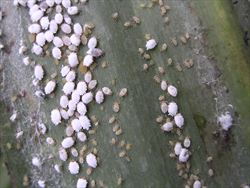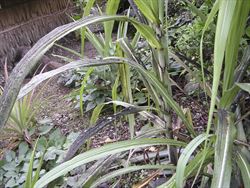Sugarcane woolly aphid. It is also known as the white sugarcane aphid.
Pacific Pests, Pathogens, Weeds & Pesticides - Online edition
Pacific Pests, Pathogens, Weeds & Pesticides
Sugarcane woolly aphid (531)
Ceratovacuna lanigera. It is a member of the Aphididae.
Asia, Oceania. It is recorded from Fiji, Papua New Guinea and Solomon Islands.
Sugarcane species, including cultivated sugarcane (Saccharum officinarum), wild sugarcane (Saccharum spontaneum), and many wild grasses (e.g., Job's tears, Johnson grass).
The aphid gives birth to living young, without mating. Males are unknown. Nymphs are oval, greenish-white or greenish-yellow (Photo 1). As they mature, they reach lengths of up to 2 mm and widths of 1.5 mm, and become covered in a white powdery wax. After three moults over 35-40 days, adults are produced. Adults are slightly larger and also covered in the white waxy (Photo 1). Winged adults are produced when colonies are large and/or food is insufficient. They leave the colony to breed elsewhere.
Invariably, leaves become covered in black sooty mould which blocks photosynthesis and reduces growth (Photos 2&3). The mould grows on the sugary honeydew excreted by the aphids as they feed.
Spread over short distances is on the wing or from the aphids being carried by the wind. Over longer distances, spread is on canes sent to the mill for crushing, 'tops' used for livestock feed or on sets used for planting.
Damage occurs directly from aphids sucking sap from leaves, and indirectly due to the production of honeydew attracting sooty mould fungi that block photosynthesis. Numerous outbreaks have been reported over large areas of India since the turn of the century. Heavy infestations reduce the sugar content of canes by up to 15%. Severe damage to crop yield and quality has also been reported from field trials in Yunnan Province, China, from 2014 to 2016.
Additionally, sugarcane woolly aphid is reported to spread Sugarcane yellow leaf virus (family Luteoviridae), the cause of yellow leaf disease in sugarcane worldwide. This virus is responsible for reduced cane growth, stalk diameter, number of millable canes, and cane yield. In recent years, the virus has become one of the most important infecting sugarcane.
Look for characteristic white waxy coverings on oval greenish aphids on the undersides of leaves - they look like miniature scorpions. Look for the blackened, mould-covered, top surfaces of leaves due to honeydew falling from aphids above. The barcoding COI (cytochrome oxidase subunit I) gene is used for identification.
BIOSECURITY
Large parts of the world remain vulnerable to infestations of this aphid and every precaution should be taken to prevent its further spread. The greatest risk is the unofficial introduction of sets infested with the aphids. Official introductions should follow the FAO/IBPGR Technical Guidelines for the Safe Movement of Sugarcane Germplasm (1993) in which preference is given to the movement of plants as virus-indexed tissue cultures.
BIOCONTROL
The ladybird beetle, Synoycha grandis, either collected from the field or reared in the laboratory, has been released in China. Early studies found the parasitoids Encarsia flavoscutellus and Diaeretus oregmae in Indonesia and the Philippines, respectively. Attempts failed to introduce Ensarsia flavoscutellum from Indonesia into Taiwan and the Philippines. In India, Micromus igorotus, a neuroteran (lacewing) predator, and Dipha aphidivora, a lepidopteran predator, have been mass produced to bring populations of the aphid under control.
CULTURAL CONTROL
Before harvest:
- Avoid sets from cane taken from infested fields.
- If ants are present (they are attracted to aphid honeydew), and the nest is in the soil, destroy it with boiling water, if plants are not at risk of damage; alternatively, use a pesticide (see below). Without ants, predators and parasites will bring about natural control.
During growth:
- Remove weeds from within and especially around blocks of sugarcane, as weeds are likely to harbour aphid populations.
- Do not apply excessive amount of (synthetic) nitrogen fertilizer as this increases aphid populations. In preference, apply organic fertilisers and manures.
- Remove infested leaves and burn them as soon as they are seen. Obviously, the labour involved in carrying out this mechanical method of control will determine its practicality. It is also said to damage 'eye' buds, and to increase lodging. On small plots, it may have potential.
After harvest:
- Collect and burn trash after harvest.
RESISTANT VARIETIES
Attempts have been made to breed resistant varieties; on those selected nymph stages were longer and populations lower. However, sap concentration were also lower, and it is not clear if useful lines were produced.
CHEMICAL CONTROL
Not a practical and economic method of control. The application of insecticides will harm natural enemies. The application of the fungus Metarhizum anisopliae may have potential, and is recommended in trial plots.
If chemical control is required, consider the following:
- Use plant-derived products, such as neem, derris, pyrethrum and chilli (with the addition of soap). (For the use of neem and chilli see Fact Sheet nos. 402, 504, respectively; for derris see Fact Sheet no. 56).
- Use white oil (made from vegetable oils), soap solution or horticultural oil (made from petroleum) (see fact sheet no. 56). Useful for smallholder plantings.
- White oil:
- 3 tablespoons (1/3 cup) cooking oil in 4 litres water
- ½ teaspoon pure hand soap, not detergent
- Shake well and use.
- Soap:
- Use soap (pure hand soap, not detergent):
- 5 tablespoons of soap in 4 litres water.
- White oil:
- Commercial horticultural oil can also be used. Spray the undersides of leaves; the oils must contact the insects. A second application of soap or oils may be necessary after 3-4 weeks. Home-made preparations are ideal for small numbers of plants, but commercial products are probably the only practical solution when crop areas are large.
- Synthetic pyrethroids are likely to be effective, but will also kill natural enemies. However, they can be used to kill ants, which often tend aphids for their honeydew, and protect them from effective control by predators and parasitoids.
--------------------
Note, derris (Derris species) contains rotenone, an insecticide, often used as a fish poison; it should be used with caution. The commercial derris insecticide is made from Derris elliptica.
____________________
When using a pesticide, always wear protective clothing and follow the instructions on the product label, such as dosage, timing of application, and pre-harvest interval. Recommendations will vary with the crop and system of cultivation. Expert advice on the most appropriate pesticide to use should always be sought from local agricultural authorities.
AUTHOR Grahame Jackson
Information from CABI (2021 Caractovacuna lanigera (sugarcane woolly aphid). Crop Protection Compendium. (https://www.cabi.org/cpc/datasheet/16271); and Frison EA, Putter CAJ (eds.) (1993) FAO/IBPGR Technical Guidelines for the Safe Movement of Sugarcane Germplasm. Food and Agriculture Organization of the United Nations, Rome/ International Board for Plant Genetic Resources, Rome. (https://www.bioversityinternational.org/fileadmin/_migrated/uploads/tx_news/Sugarcane_259.pdf); and from Joshi S, Viraktamath CA (2004) The sugarcane woolly aphid, Ceratovacuna lanigera Zehntner (Hemiperta: Aphididae): its biology, pest status and control. Current Science 87(3): 307-316.
Produced with support from the Australian Centre for International Agricultural Research under project HORT/2016/185: Responding to emerging pest and disease threats to horticulture in the Pacific islands, implemented by the University of Queensland, in association with the Pacific Community.






